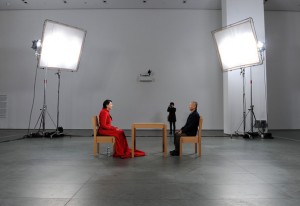“This Is An Enormous Amount of Eyes”
 I have been stark-raving-obsessed with Marina Abramović’s The Artist is Present. I’ve spent hours at MoMA; I’ve interacted with the interactive website; I’ve scrolled through the Flikr; I’ve learned about other obsessives; I’ve read essays and reviews; I’ve watched this nifty video; And yeah, I’ve seen that blog that is just the pictures of people crying. (Love that one.) I know Ken has posted links to it twice since it’s been going on, but I’m posting them again, at risk of redundancy, because to me (and many others) this was a huge moment in art history and I think anyone who is alive and creating things right now should know about it.
I have been stark-raving-obsessed with Marina Abramović’s The Artist is Present. I’ve spent hours at MoMA; I’ve interacted with the interactive website; I’ve scrolled through the Flikr; I’ve learned about other obsessives; I’ve read essays and reviews; I’ve watched this nifty video; And yeah, I’ve seen that blog that is just the pictures of people crying. (Love that one.) I know Ken has posted links to it twice since it’s been going on, but I’m posting them again, at risk of redundancy, because to me (and many others) this was a huge moment in art history and I think anyone who is alive and creating things right now should know about it.
Memorial Day was the last day for the exhibit and now Marina has given a pretty interesting exit interview to the WSJ blog Speakeasy. It’s full of such non-native-English-speaker sentences like, They made a lot of interesting drawings of how I pee. I didn’t even have urge. and This is an enormous amount of eyes. The interview also refers to an earlier statement she has made that “nobody ever changes when they do things they like.”
I am not sure if I entirely agree with that but it does raise some interesting questions. I know a lot of writers who say they hate writing, but they do it anyway. I don’t know how to react when someone tells me this. Are they masochists or do they feel like they can’t do anything else? I often find writing really difficult and trying, but I almost always like it. So will I never change or grow as a writer because I enjoy it so much? READ MORE >
Mini mess: an interview with ‘MoMA’s Mystery Man’ & Ludwig Wittgenstein’s Collected Works as a free .pdf (via UbuWeb).
@MoMa

Paola Antonelli of MoMa has written an short post dedicated to celebrating MoMa’s ‘acquiring’ the @ symbol into the collection. I didn’t know much about the @ symbol, so I thought it was a pretty good read. Here’s a bit for you:
The appropriation and reuse of a pre-existing, even ancient symbol—a symbol already available on the keyboard yet vastly underutilized, a ligature meant to resolve a functional issue (excessively long and convoluted programming language) brought on by a revolutionary technological innovation (the Internet)—is by all means an act of design of extraordinary elegance and economy. Without any need to redesign keyboards or discard old ones, [Ray] Tomlinson gave the @ symbol a completely new function that is nonetheless in keeping with its origins, with its penchant for building relationships between entities and establishing links based on objective and measurable rules—a characteristic echoed by the function @ now embodies in computer programming language. Tomlinson then sent an email about the @ sign and how it should be used in the future. He therefore consciously, and from the very start, established new rules and a new meaning for this symbol.
